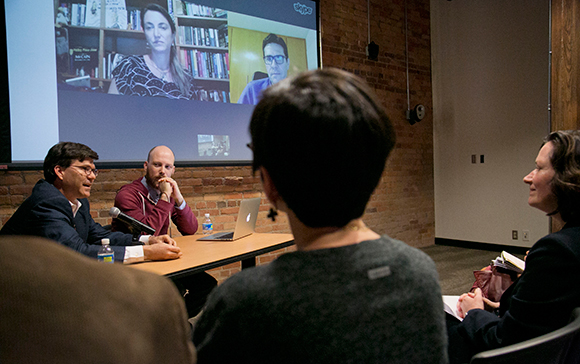
Dr. Chris Woods, left, speaks during Zika!: Journalism and Public Health Confront a New Epidemic, as moderator Jonathan Katz and Deborah Jenson listen. Joining in the discussion via Skype are Patricia Campos Mello of Folha de S. Paulo and Simon Romero of the New York Times. Photo by Jared Lazarus/Duke Photography
Less than a year ago, Simon Romero had not even heard of microcephaly, a birth defect that afflicts infants with abnormally small heads and frequent seizures. Sitting at his kitchen table in Rio de Janeiro last October, the Brazil bureau chief for the New York Times read a local news report about the alarming increase of microcephaly cases in Brazil’s impoverished northeastern states.
The likely cause of this condition, as Romero, other journalists and medical researchers would soon discover, was a mosquito-transmitted virus called Zika.
“It immediately caught my attention, and I started researching Zika more thoroughly,” Romero told a Duke audience Thursday. “It felt like putting together a puzzle because so much about the disease and its complications was unknown.”
Romero is now on the frontlines of covering the Zika outbreak, which has spread across Latin America and the Caribbean, including Puerto Rico and parts of the United States. He has authored more than a dozen articles on the Zika virus, including a December 30, 2015, story that ran on the front page of the New York Times and launched much of the US media coverage of the disease.
Speaking over a Skype video call from his home in Rio de Janeiro, Romero joined a panel of experts Thursday to discuss the effects of this virus on Brazil’s population and the surprising amount of media coverage it has received in the United States since the beginning of 2016.
The panel was moderated by Jonathan M. Katz, a former Associated Press reporter who covered both the Haiti earthquake of 2010 and the subsequent cholera outbreak and contracted Zika while reporting from that country earlier this winter. Katz is now a writer-in-residence at Duke’s Franklin Humanities Institute, which sponsored the panel.
The panel also featured Dr. Chris Woods, co-director of the Hubert-Yeargan Center for Global Health and a professor of medicine and global health, and Brazilian reporter Patricia Campos Mello, an editor-at-large with Sao Paulo’s largest newspaper, Folha de S. Paulo. Like Romero, Campos Mello participated in the discussion remotely from her home in Sao Paulo.
According to the Centers for Disease Control and Prevention (CDC), the Zika virus, transmitted by the Aedes aegypti mosquito, only inflicts its hosts with mild symptoms like a low fever, rash and aching joints. But pregnant women who contract the virus face a greater risk of giving birth to an infant with microcephaly. While the CDC published a report that confirmed the causal relationship between Zika and microcephaly just minutes before Thursday’s panel, Campos Mello says that data about the disease’s victims in Brazil is still difficult to collect due to the remoteness of many of the northeastern communities devastated by the virus.
“You can’t trust the data,” Campos Mello said. “In most of Brazil, it is only possible to diagnose the dengue virus and not Zika because the symptoms are so similar. The Ministry of Health has said the number of cases could range between 500 thousand and 1.5 million.”
Campos Mello added that the remoteness of states like Bahia and Pernambuco, which have been hardest-hit with cases of microcephaly, contributed to the initial lack of both public and media interest in the Zika virus.
“Because the outbreak was not in the big financial, industrial centers of the country, the news outlets were just not paying attention,” Mello Campos said. “It was just another year we had a dengue-like disease in our country. People did not care until they saw photos of babies with microcephaly.”
Just a few months after urban Brazilians first read reports of the Zika virus and microcephaly, the little-known microbe came to dominate the US news cycle. The panel attributed this intense coverage to the frequency of American travel to Caribbean countries, where Aedes aegypti thrives, and the upcoming summer Olympic Games in Rio de Janeiro. Campos Mello and Romero noted that as US concern over Zika has grown since the end of 2015, coverage of the virus in Brazil has actually waned because of the mounting corruption scandal against President Dilma Rousseff and her cabinet, as well as a severe H1N1 “swine flu” outbreak in Sao Paulo.
Woods called the coverage of medical conditions in the mainstream media a “double-edged sword.” While the 24-hour news cycle can help create public health awareness, it might also facilitate the spread of false information.
“To get funders and to create a highly invested public health response, I think one needs the media,” Woods said. “It’s a very important tool. But with that comes the potential for misinformation. Sometimes the public’s excitement and concern over [an infectious disease] reaches such high levels that the media coverage is no longer helpful for us in the medical community.”
Woods added that preventing Duke students from travelling to Zika-affected areas is unwise because the disease “does not respect borders anyway” and has already made its way into US territories. As far as medical experts can discern, Woods said, Zika has much less severe health consequences for non-pregnant individuals than other diseases transmitted by Aedes aegyptis, including dengue, chikunguya and yellow fever.
For more information on upcoming FHI events, click here.